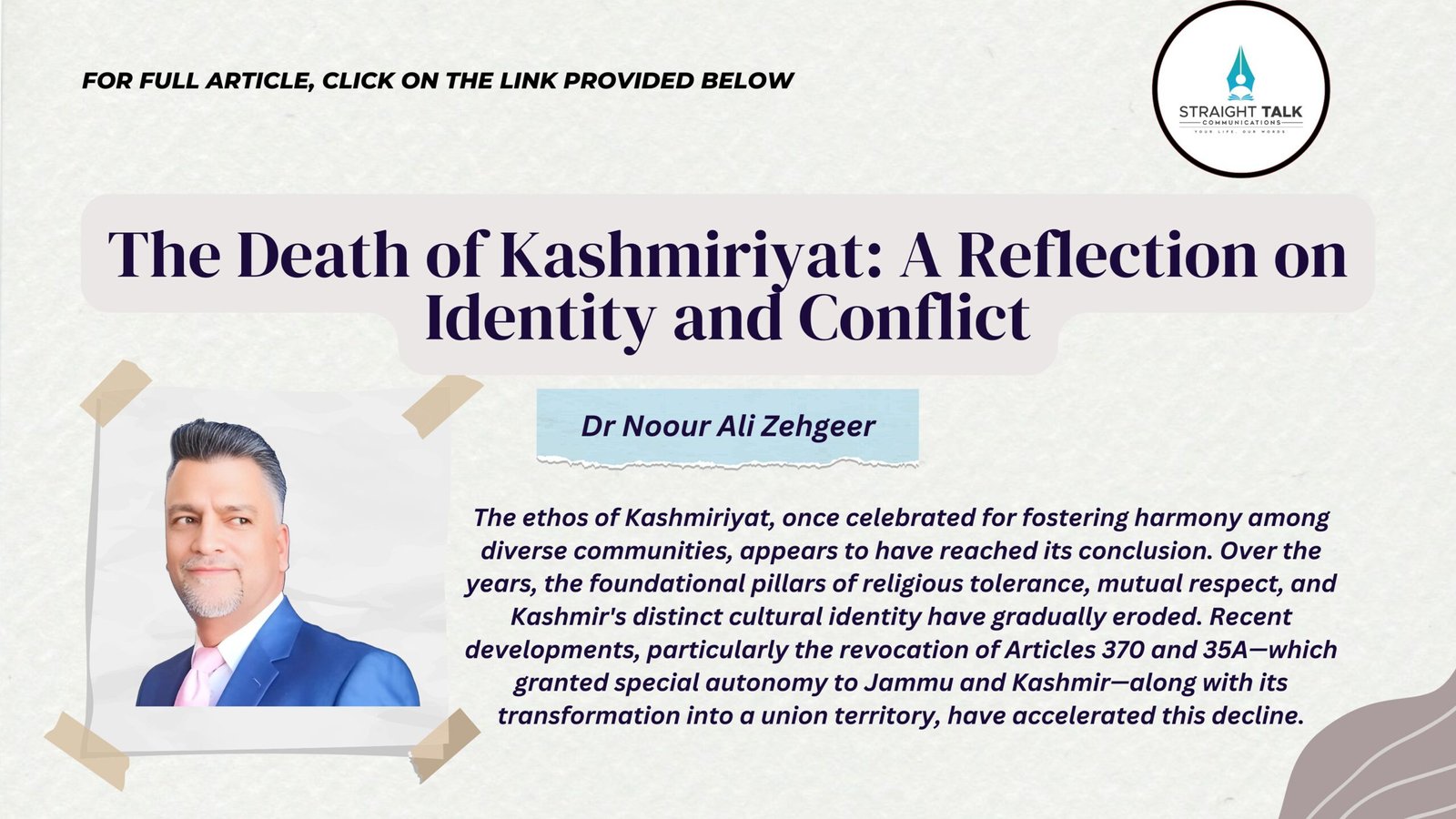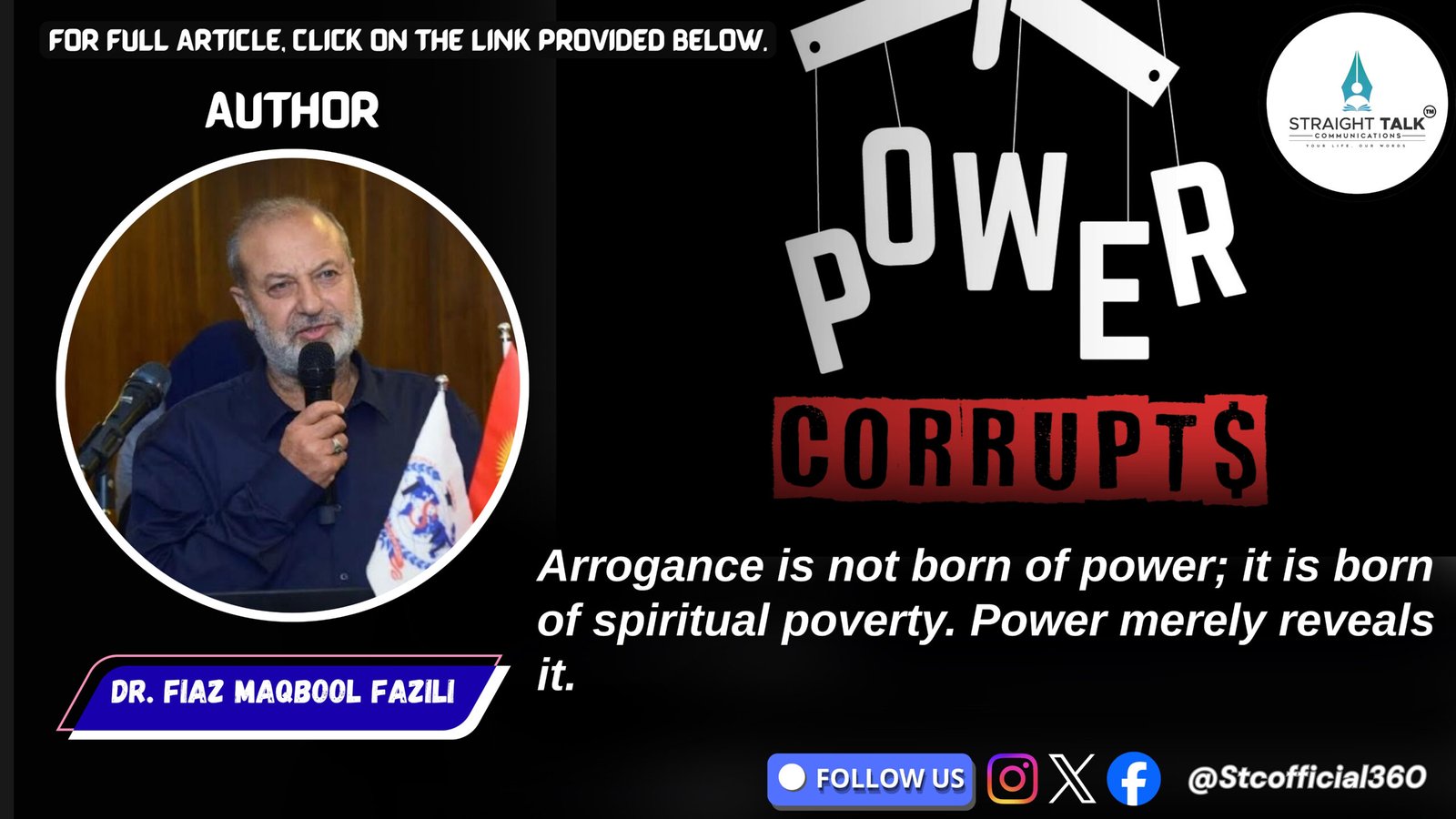The Death of Kashmiriyat: A Reflection on Identity and Conflict

Dr Noour Ali Zehgeer
The ethos of Kashmiriyat, once celebrated for fostering harmony among diverse communities, appears to have reached its conclusion. Over the years, the foundational pillars of religious tolerance, mutual respect, and Kashmir’s distinct cultural identity have gradually eroded. Recent developments, particularly the revocation of Articles 370 and 35A—which granted special autonomy to Jammu and Kashmir—along with its transformation into a union territory, have accelerated this decline. These changes signify a substantial shift, obliterating the constitutional and emotional uniqueness that previously distinguished Kashmir within the Indian framework. The once cherished idea of Kashmiriyat now feels like a distant memory, overshadowed by political and social transformations.
The death of Kashmiriyat symbolizes not just the loss of an idea but also reflects the broader political and social shifts that have taken place in the region
Origin of Kashmiriyat
The notion of Kashmiriyat, which emphasizes Kashmir’s unique identity, emerged from the intertwining of Kashmiri and Indian nationalism during the early 20th century. However, its roots extend much deeper, embedded in the region’s rich Sanskrit and Persian traditions. These narratives passed down through generations, highlighted the sanctity of Kashmir’s land, its profound historical legacy, and the coexistence of its diverse inhabitants. By the late 19th century, this sense of distinctiveness had become ingrained in the region’s identity.
For centuries, Kashmir’s claim to exceptionality allowed it to carve out a significant role within larger, more dominant empires, ensuring that its voice and culture remained relevant on a broader geopolitical stage. The idyllic portrayal of Kashmir as a land of beauty and harmony became foundational to its cultural identity.
The Shift in Focus
By the turn of the 20th century, as Kashmiri Muslims began mobilizing against the Hindu Maharaja of Jammu and Kashmir, the earlier emphasis on Kashmir’s uniqueness gave way to more pressing concerns. The anti-Maharaja movement, which gained momentum in the late 1920s and early 1930s, centred on protecting Muslim identity and religion. The primary demand was to address the exclusion of Kashmiri Muslims from government employment, overshadowing broader concerns about the economic hardships faced by peasants, labourers, and minority communities.
By the mid-1930s, the movement reached a crossroads. Internal and external pressures grew, with factions criticizing it for being either too focused on Muslim issues or not sufficiently addressing their rights. This internal debate led some leaders to recognize the need to expand their agenda beyond purely religious grievances and embrace the causes of marginalized and underrepresented groups.
Political Realignment
At this critical juncture, the Indian National Congress began to expand its influence over princely states, launching a Muslim mass-contact program to attract more Muslim support. The prospect of aligning with a Muslim-majority princely state like Jammu and Kashmir became appealing to the Congress, as it promised to enhance its reach within Muslim communities. This growing interest, combined with the evolving dynamics of the anti-Maharaja movement, set the stage for a deeper political realignment in the region.
Kashmiri nationalism faced considerable resistance from various quarters, particularly among Kashmiri Muslims and the larger Indian Muslim community. Many felt the movement had strayed from its original purpose of safeguarding Muslim rights, central to the struggle against the Maharaja’s rule. The shift toward a more inclusive, secular nationalist agenda was perceived by some as a compromise of Muslim interests, particularly given the increasing ties between the National Conference and the Indian National Congress.
This dissatisfaction was further compounded by fears that aligning with Congress might dilute the specific grievances of Kashmiri Muslims, who had long faced marginalization under the Maharaja’s regime. The criticism was not solely ideological; it extended to concerns that a broader nationalist agenda would overshadow the needs of the local Muslim population.
The Role of Leadership
Despite these reservations, a majority of Kashmiri Muslims rallied behind Sheikh Abdullah, whose persuasive leadership helped many overlook the tensions between religion and nationalism. Abdullah’s vision of a secular, inclusive movement for Kashmir resonated with a broad cross-section of society, positioning him as a unifying figure amid the fractures within the larger Muslim community. His influence was instrumental in garnering widespread acceptance for the nationalist cause, even as dissent from certain factions persisted.
Insurgency and Its Aftermath
The concept of Kashmiriyat encountered significant challenges during the Kashmiri resistance movement, which began to be perceived as linked to Indian nationalism—an expression of sub-nationalism aimed at forcibly incorporating Kashmir into India. In this new context, Kashmir’s historical narrative was revised to emphasize its connections to Central Asia, distancing it from the Indian subcontinent. This shift fostered an oppositional identity rooted in Islam, leading to the erasure of Kashmir’s pre-Islamic heritage.
As Kashmiriyat was initially developed to include diverse communities, it became increasingly irrelevant as minority populations diminished in the Valley, either through voluntary migration or forced exodus. The younger generation of Kashmiri Muslims, shaped by ongoing violence and repression from Indian security forces, is largely unfamiliar with the concept of Kashmiriyat, perceiving it as outdated. When it surfaces in intellectual circles, it is often met with strong rejection due to its ties to India.
The Erosion of Secular Consensus
The decline of Kashmiriyat must be contextualized within the broader erosion of secular consensus across India. The rise of the Bharatiya Janata Party (BJP) and the accompanying growth of Hindu majoritarianism can be traced back to the onset of the Kashmir insurgency, both representing a departure from the secular principles on which the Indian state was founded. Although the insurgency and the BJP’s prominence have fluctuated over the past three decades, it appears that the majoritarian narratives associated with both are now deeply entrenched.
This situation is troubling for several reasons, particularly because it leaves little room for a viable resolution to the Kashmir conflict. The BJP seems to believe that the only way forward is through applying brute force, effectively sidelining the possibility of dialogue or compromise.
A Nostalgic Relic
Today, Kashmiriyat is a relic of the past, often referenced in somber whispers within liberal circles or occasionally in classrooms, accompanied by a sense of nostalgia for a time when peace and harmony thrived. If only the past were as uncomplicated as it seems. The complexity of Kashmir’s history reveals a tapestry woven from threads of diverse identities, cultural richness, and historical struggles.
As Kashmiriyat fades, it is imperative to recognize the importance of dialogue and understanding in addressing the region’s current challenges. The way forward must involve acknowledging the multifaceted nature of Kashmir’s identity and fostering an inclusive discourse that honours its diverse heritage while seeking paths toward reconciliation and peace.
Conclusion
The death of Kashmiriyat symbolizes not just the loss of an idea but also reflects the broader political and social shifts that have taken place in the region. As Kashmir navigates its future, the lessons from its past—marked by both unity and division—remain crucial for fostering a more harmonious and inclusive society. The hope lies in reviving the spirit of Kashmiriyat, not merely as a nostalgic memory but as a living, evolving identity that embraces the richness of its diverse communities.
(The views expressed in the article are exclusively of the author and not of the Straight Talk Communications)







